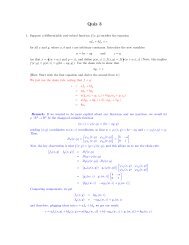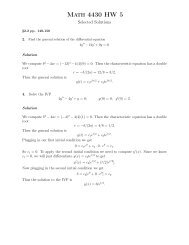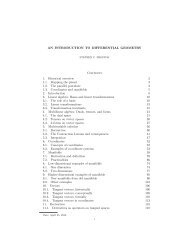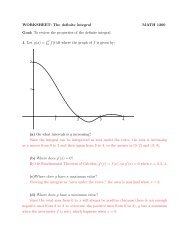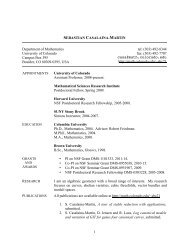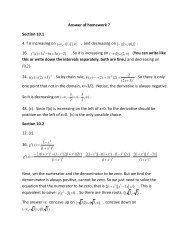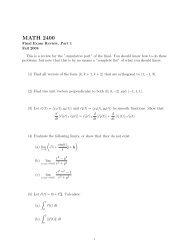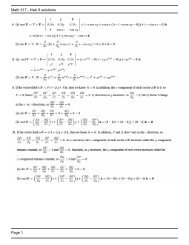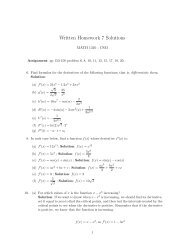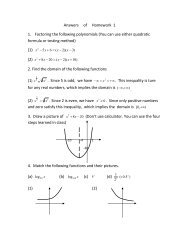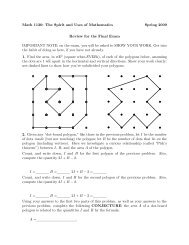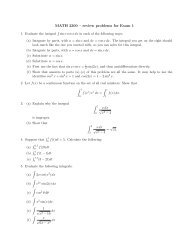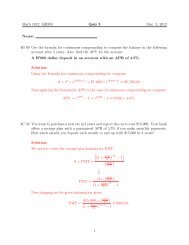Section 1-2 10) If .2-oz of catsup is used on each of 22 billion ...
Section 1-2 10) If .2-oz of catsup is used on each of 22 billion ...
Section 1-2 10) If .2-oz of catsup is used on each of 22 billion ...
Create successful ePaper yourself
Turn your PDF publications into a flip-book with our unique Google optimized e-Paper software.
<str<strong>on</strong>g>Secti<strong>on</strong></str<strong>on</strong>g> 1-2<br />
<str<strong>on</strong>g>10</str<strong>on</strong>g>) <str<strong>on</strong>g>If</str<strong>on</strong>g> <str<strong>on</strong>g>.2</str<strong>on</strong>g>-<str<strong>on</strong>g>oz</str<strong>on</strong>g> <str<strong>on</strong>g>of</str<strong>on</strong>g> <str<strong>on</strong>g>catsup</str<strong>on</strong>g> <str<strong>on</strong>g>is</str<strong>on</strong>g> <str<strong>on</strong>g>used</str<strong>on</strong>g> <strong>on</strong> <strong>each</strong> <str<strong>on</strong>g>of</str<strong>on</strong>g> <strong>22</strong> billi<strong>on</strong> hamburgers, how many 16-<str<strong>on</strong>g>oz</str<strong>on</strong>g> bottles<br />
<str<strong>on</strong>g>of</str<strong>on</strong>g> <str<strong>on</strong>g>catsup</str<strong>on</strong>g> are needed?<br />
First we find how many hamburgers 1 bottle <str<strong>on</strong>g>of</str<strong>on</strong>g> ketchup provides for:<br />
Let x=the number <str<strong>on</strong>g>of</str<strong>on</strong>g> hamburgers per bottle<br />
<str<strong>on</strong>g>.2</str<strong>on</strong>g>x=16<br />
2x=160<br />
x=80<br />
So <strong>each</strong> bottle <str<strong>on</strong>g>of</str<strong>on</strong>g> ketchup takes care <str<strong>on</strong>g>of</str<strong>on</strong>g> 80 hamburgers.<br />
Now we find how many bottles we need for <strong>22</strong> billi<strong>on</strong> hamburgers:<br />
Let y=the number <str<strong>on</strong>g>of</str<strong>on</strong>g> bottles needed<br />
80y=<strong>22</strong>,000,000,000<br />
y=275,000,000<br />
So it takes 275 milli<strong>on</strong> bottles <str<strong>on</strong>g>of</str<strong>on</strong>g> ketchup.<br />
11) Place the digits 1, 2, 4, 5, and 7 in the boxes to get the greatest product and the<br />
greatest quotient.<br />
To get the greatest product, we want our numbers to be as big as possible, so we<br />
put our higher numbers in the spots with higher place value. By experimentati<strong>on</strong><br />
(a.k.a. the guess and check method) we find that 541*72 gives the biggest<br />
product.<br />
To get the greatest quotient, we want our div<str<strong>on</strong>g>is</str<strong>on</strong>g>or to be as small as possible and the<br />
number we’re dividing to be as large as possible. So 754 divided by 12 yields the<br />
greatest quotient.<br />
In part b we do the opposite to find the smallest product and the smallest quotient:<br />
257*14 and 124 divided by 75.<br />
18) How many faces <str<strong>on</strong>g>of</str<strong>on</strong>g> the cube stack need to be painted in the <str<strong>on</strong>g>10</str<strong>on</strong>g> th stack? In the n th<br />
stack?<br />
Let’s make a chart:<br />
Stack<br />
number<br />
# <str<strong>on</strong>g>of</str<strong>on</strong>g><br />
exposed<br />
faces<br />
facing<br />
the fr<strong>on</strong>t<br />
# <str<strong>on</strong>g>of</str<strong>on</strong>g><br />
exposed<br />
faces <strong>on</strong><br />
the back<br />
# <str<strong>on</strong>g>of</str<strong>on</strong>g><br />
exposed<br />
faces <strong>on</strong><br />
the<br />
bottom<br />
# <str<strong>on</strong>g>of</str<strong>on</strong>g><br />
exposed<br />
faces<br />
facing<br />
up<br />
# <str<strong>on</strong>g>of</str<strong>on</strong>g><br />
exposed<br />
faces <strong>on</strong><br />
the left<br />
1 1 1 1 1 1 1<br />
2 2 2 2 2 3 3<br />
3 3 3 3 3 6 6<br />
4 4 4 4 4 <str<strong>on</strong>g>10</str<strong>on</strong>g> <str<strong>on</strong>g>10</str<strong>on</strong>g><br />
# <str<strong>on</strong>g>of</str<strong>on</strong>g><br />
exposed<br />
faces <strong>on</strong><br />
the right<br />
Hopefully you’re seeing a pattern here. The number <str<strong>on</strong>g>of</str<strong>on</strong>g> exposed faces <strong>on</strong> <strong>each</strong> <str<strong>on</strong>g>of</str<strong>on</strong>g><br />
the fr<strong>on</strong>t, the back, the top, and the bottom <str<strong>on</strong>g>is</str<strong>on</strong>g> the same as the stack number. On<br />
<strong>each</strong> the left and right, we have the same number as the number <str<strong>on</strong>g>of</str<strong>on</strong>g> cubes. How
many cubes do we have in <strong>each</strong> stack? There’s 1 in the first stack. When we go<br />
to the sec<strong>on</strong>d stack, we keep that 1 and add 2 more. In the third stack, we have<br />
the 3 from the sec<strong>on</strong>d stack and add three more. In the fourth stack, we add four.<br />
Etc… So the number <str<strong>on</strong>g>of</str<strong>on</strong>g> cubes in <strong>each</strong> stack <str<strong>on</strong>g>is</str<strong>on</strong>g> 1+2+3+…+n.<br />
And we know a formula for that! We figured that out last week.<br />
1+2+3+…+n = n(n+1)/2<br />
(<str<strong>on</strong>g>If</str<strong>on</strong>g> you d<strong>on</strong>’t know why that <str<strong>on</strong>g>is</str<strong>on</strong>g>, you should come to my <str<strong>on</strong>g>of</str<strong>on</strong>g>fice hours and figure it<br />
out. It’s important!!)<br />
So c<strong>on</strong>tinuing our chart we get:<br />
Stack<br />
number<br />
# <str<strong>on</strong>g>of</str<strong>on</strong>g><br />
exposed<br />
faces<br />
facing<br />
the fr<strong>on</strong>t<br />
# <str<strong>on</strong>g>of</str<strong>on</strong>g><br />
exposed<br />
faces <strong>on</strong><br />
the back<br />
# <str<strong>on</strong>g>of</str<strong>on</strong>g><br />
exposed<br />
faces <strong>on</strong><br />
the<br />
bottom<br />
# <str<strong>on</strong>g>of</str<strong>on</strong>g><br />
exposed<br />
faces<br />
facing<br />
up<br />
# <str<strong>on</strong>g>of</str<strong>on</strong>g><br />
exposed<br />
faces <strong>on</strong><br />
the left<br />
# <str<strong>on</strong>g>of</str<strong>on</strong>g><br />
exposed<br />
faces <strong>on</strong><br />
the right<br />
n n n n n n(n+1)/2 n(n+1)/2<br />
The total number <str<strong>on</strong>g>of</str<strong>on</strong>g> faces we have <str<strong>on</strong>g>is</str<strong>on</strong>g> just the sum <str<strong>on</strong>g>of</str<strong>on</strong>g> the fr<strong>on</strong>t, back, top, bottom,<br />
left and right, which <str<strong>on</strong>g>is</str<strong>on</strong>g> 4n+n(n+1). Or if you regroup the terms you get n 2 +5n.<br />
So the <str<strong>on</strong>g>10</str<strong>on</strong>g>0 th stack has <str<strong>on</strong>g>10</str<strong>on</strong>g>0 2 +5*<str<strong>on</strong>g>10</str<strong>on</strong>g>0 = <str<strong>on</strong>g>10</str<strong>on</strong>g>,500 faces to be painted.<br />
<strong>22</strong>a) Find 1+6+11+16+…+<str<strong>on</strong>g>10</str<strong>on</strong>g>01<br />
The addends in th<str<strong>on</strong>g>is</str<strong>on</strong>g> sum make an arithmetic sequence. The first term <str<strong>on</strong>g>is</str<strong>on</strong>g> 1, and the<br />
difference between terms <str<strong>on</strong>g>is</str<strong>on</strong>g> 5. Let’s make a new sequence that starts at 5<br />
(because 5 <str<strong>on</strong>g>is</str<strong>on</strong>g> the difference in the sequence). <str<strong>on</strong>g>If</str<strong>on</strong>g> we add 4 to <strong>each</strong> term, we get the<br />
arithmetic sequence 5, <str<strong>on</strong>g>10</str<strong>on</strong>g>, 15, …<str<strong>on</strong>g>10</str<strong>on</strong>g>05, which has the same number <str<strong>on</strong>g>of</str<strong>on</strong>g> terms as<br />
our original sequence. Dividing <str<strong>on</strong>g>10</str<strong>on</strong>g>05 by 5 we get 201. So there are 201 terms in<br />
our new sequence, which means there were 201 terms in our original sequence.<br />
That’s all we needed to know, so we’ll forget about the new sequence and just<br />
look at our original sequence. We want to use the pair trick to find the sum. But<br />
we have 201 terms, which <str<strong>on</strong>g>is</str<strong>on</strong>g> an odd number. So we’ll leave out the <str<strong>on</strong>g>10</str<strong>on</strong>g>01 for a<br />
minute. Now we have 1+6+11+16+…+986+991+996. We have 200 terms in th<str<strong>on</strong>g>is</str<strong>on</strong>g><br />
sequence, so we can put them all in pairs. We’ll pair the first and last term, and<br />
adding them we get 997. The sec<strong>on</strong>d term and sec<strong>on</strong>d to last term (6 and 991)<br />
also add up to 997. The third and third to last term (16 and 986) also add up to<br />
997. In fact, if we keep pairing up the numbers, they’ll keep adding up to 997.<br />
So we just need to add 997+997+997+997…. How many times should we add<br />
th<str<strong>on</strong>g>is</str<strong>on</strong>g>? There were 200 numbers, so pairing them up gives <str<strong>on</strong>g>10</str<strong>on</strong>g>0 pairs. So we need<br />
to add 997 <strong>on</strong>e hundred times. Th<str<strong>on</strong>g>is</str<strong>on</strong>g> <str<strong>on</strong>g>is</str<strong>on</strong>g> easy to do using multiplicati<strong>on</strong>.<br />
997x<str<strong>on</strong>g>10</str<strong>on</strong>g>0=99700. So 1+6+11+…+991+996=99700. Now we just have to add<br />
<str<strong>on</strong>g>10</str<strong>on</strong>g>01 (since we left it out before) and we’ll have our whole sum:<br />
1+6+…+991+996+<str<strong>on</strong>g>10</str<strong>on</strong>g>01 = (1+6+…+991+996)+<str<strong>on</strong>g>10</str<strong>on</strong>g>01 = 99,700+1,001 = <str<strong>on</strong>g>10</str<strong>on</strong>g>0,701<br />
b) 3+7+11+15+…+403<br />
We’re going to do the same thing we did in the last problem.<br />
First, we notice that the difference between terms <str<strong>on</strong>g>is</str<strong>on</strong>g> 4.
Next, we find out how many numbers are in our sequence.<br />
4, 8, 12, …, 404 has the same number <str<strong>on</strong>g>of</str<strong>on</strong>g> terms, but it starts <strong>on</strong> 4, which <str<strong>on</strong>g>is</str<strong>on</strong>g> our<br />
difference. 404 divided by 4 <str<strong>on</strong>g>is</str<strong>on</strong>g> <str<strong>on</strong>g>10</str<strong>on</strong>g>1 so there are <str<strong>on</strong>g>10</str<strong>on</strong>g>1 terms in our sequence.<br />
We’ll leave out 403 for a minute, because we want an even number <str<strong>on</strong>g>of</str<strong>on</strong>g> terms so<br />
that we can put them in pairs.<br />
We have 3+7+11+15+…+395+399<br />
3+399=402, 7+395=402, 11+391=402, etc….<br />
We have <str<strong>on</strong>g>10</str<strong>on</strong>g>0 numbers, so we have 50 pairs <str<strong>on</strong>g>of</str<strong>on</strong>g> numbers.<br />
So 3+7+11+15+…+300 = 50x402 = 20,<str<strong>on</strong>g>10</str<strong>on</strong>g>0<br />
Now just add the 403 back in and we get 20,503.<br />
29) How many breaths do you take in a year?<br />
On th<str<strong>on</strong>g>is</str<strong>on</strong>g> questi<strong>on</strong> I’m much more c<strong>on</strong>cerned with your reas<strong>on</strong>ing process than your<br />
answer. There’s not <strong>on</strong>e right answer. But here’s the reas<strong>on</strong>ing process I <str<strong>on</strong>g>used</str<strong>on</strong>g><br />
and the answer I got:<br />
I counted my breaths for a minute and found that I take about 20 breaths per<br />
minute. It’s actually probably a little less than that, but I rounded up, figuring that<br />
I breathe faster when I’m exerc<str<strong>on</strong>g>is</str<strong>on</strong>g>ing, so that will increase my average.<br />
20 breaths per minute times 60 gives 1200 breaths per hour.<br />
1200x24 gives 28,800 breaths per day<br />
28,800x365 gives <str<strong>on</strong>g>10</str<strong>on</strong>g>,512,000 breaths per year.<br />
<str<strong>on</strong>g>Secti<strong>on</strong></str<strong>on</strong>g> 1-3<br />
3) <str<strong>on</strong>g>If</str<strong>on</strong>g> 1 U.S. dollar <str<strong>on</strong>g>is</str<strong>on</strong>g> worth 1.35 Sw<str<strong>on</strong>g>is</str<strong>on</strong>g>s francs, and 1 Sw<str<strong>on</strong>g>is</str<strong>on</strong>g>s franc <str<strong>on</strong>g>is</str<strong>on</strong>g> worth 1<str<strong>on</strong>g>.2</str<strong>on</strong>g>2 Dutch<br />
gilders, find a formula that will give a U.S. tour<str<strong>on</strong>g>is</str<strong>on</strong>g>t the amount <str<strong>on</strong>g>of</str<strong>on</strong>g> Dutch gilders g for U.S.<br />
dollars d.<br />
We can represent these relati<strong>on</strong>ships with equati<strong>on</strong>s.<br />
<str<strong>on</strong>g>If</str<strong>on</strong>g> 1 U.S. dollar <str<strong>on</strong>g>is</str<strong>on</strong>g> worth 1.35 Sw<str<strong>on</strong>g>is</str<strong>on</strong>g>s francs, we write 1d=1.35f<br />
and if 1 Sw<str<strong>on</strong>g>is</str<strong>on</strong>g>s franc <str<strong>on</strong>g>is</str<strong>on</strong>g> worth 1<str<strong>on</strong>g>.2</str<strong>on</strong>g>2 Dutch gilders, we write 1f=1<str<strong>on</strong>g>.2</str<strong>on</strong>g>2g<br />
So we have francs in <strong>each</strong> formula, but we can’t compare them yet because in <strong>on</strong>e<br />
equati<strong>on</strong> we have 1f and in the other we have 1.35f. So we want to change our<br />
first equati<strong>on</strong> so that <str<strong>on</strong>g>is</str<strong>on</strong>g> has 1f, just like the other <strong>on</strong>e. How can we change 1.35f<br />
to 1f? Since 1.35f <str<strong>on</strong>g>is</str<strong>on</strong>g> multiplicati<strong>on</strong> (that’s really 1.35 times 1f), we use the inverse<br />
(or opposite) operati<strong>on</strong>: div<str<strong>on</strong>g>is</str<strong>on</strong>g>i<strong>on</strong>. We’ll divide 1.35f by 1.35. That gives us 1f.<br />
But to keep our equati<strong>on</strong> balanced, we have to do the same thing to both sides <str<strong>on</strong>g>of</str<strong>on</strong>g><br />
the equati<strong>on</strong>. So we divide 1d by 1.35 as well. 1d÷1.35=.74d. Now we know<br />
that 1f=.74d. We also know that 1f=1<str<strong>on</strong>g>.2</str<strong>on</strong>g>2g. So since .74d and 1<str<strong>on</strong>g>.2</str<strong>on</strong>g>2g are <strong>each</strong><br />
equal to 1f, they must be equal to <strong>each</strong> other! So we write our new equati<strong>on</strong><br />
.74d=1<str<strong>on</strong>g>.2</str<strong>on</strong>g>2g.<br />
Now, we want to get back to having 1d <strong>on</strong> the left. How can we get there? We’ll<br />
divide again. .74d÷.74=1d. Doing the same thing to the other side gives us<br />
1<str<strong>on</strong>g>.2</str<strong>on</strong>g>2g÷.74=1.65g. So 1d=1.65g. You’ll get 1.65 Dutch gilders for every dollar<br />
you exchange.
4) Joel <str<strong>on</strong>g>is</str<strong>on</strong>g> designing squares made <str<strong>on</strong>g>of</str<strong>on</strong>g> matchsticks. How many matchsticks will had need<br />
for a <str<strong>on</strong>g>10</str<strong>on</strong>g>x<str<strong>on</strong>g>10</str<strong>on</strong>g> square? An nxn square?<br />
Th<str<strong>on</strong>g>is</str<strong>on</strong>g> <str<strong>on</strong>g>is</str<strong>on</strong>g> another <strong>on</strong>e <str<strong>on</strong>g>of</str<strong>on</strong>g> those look for a pattern and find a formula problems. Let’s<br />
make a table again:<br />
N 1 2 3 4 5<br />
Number <str<strong>on</strong>g>of</str<strong>on</strong>g><br />
vertical<br />
matchsticks<br />
Number <str<strong>on</strong>g>of</str<strong>on</strong>g><br />
horiz<strong>on</strong>tal<br />
matchsticks<br />
2<br />
(1 row <str<strong>on</strong>g>of</str<strong>on</strong>g><br />
2)<br />
6<br />
(3 per row<br />
times 2<br />
rows<br />
12<br />
(4 per row<br />
times 3<br />
rows)<br />
20<br />
(5 per row<br />
times 4<br />
rows)<br />
30<br />
(6 per row<br />
times 5<br />
rows)<br />
2 6 12 20 30<br />
Ok, what kind <str<strong>on</strong>g>of</str<strong>on</strong>g> pattern do we see? First, let’s notice that the number <str<strong>on</strong>g>of</str<strong>on</strong>g><br />
horiz<strong>on</strong>tal matchsticks <str<strong>on</strong>g>is</str<strong>on</strong>g> the same as the number <str<strong>on</strong>g>of</str<strong>on</strong>g> vertical <strong>on</strong>es, so we <strong>on</strong>ly need<br />
to worry about calculating the vertical <strong>on</strong>es.<br />
Notice that in <strong>each</strong> step, the number <str<strong>on</strong>g>of</str<strong>on</strong>g> rows <str<strong>on</strong>g>is</str<strong>on</strong>g> the same as the step number. That<br />
<str<strong>on</strong>g>is</str<strong>on</strong>g>, in step n, we have n rows. And we also notice that in <strong>each</strong> row we have <strong>on</strong>e<br />
more matchstick than rows. That <str<strong>on</strong>g>is</str<strong>on</strong>g>, in step n we have n+1 matchsticks. And the<br />
total number <str<strong>on</strong>g>of</str<strong>on</strong>g> (vertical) matchsticks <str<strong>on</strong>g>is</str<strong>on</strong>g> the number <str<strong>on</strong>g>of</str<strong>on</strong>g> rows times the number <str<strong>on</strong>g>of</str<strong>on</strong>g><br />
matchsticks. That <str<strong>on</strong>g>is</str<strong>on</strong>g>, in step n we have n(n+1) vertical matchsticks. And since<br />
we have the same number <str<strong>on</strong>g>of</str<strong>on</strong>g> horiz<strong>on</strong>tal matchsticks, we add those, giving us our<br />
grand total <str<strong>on</strong>g>of</str<strong>on</strong>g> n(n+1) + n(n+1). Which <str<strong>on</strong>g>is</str<strong>on</strong>g> equal to 2n(n+1).<br />
7) Write an equati<strong>on</strong> relating the variables described in <strong>each</strong> <str<strong>on</strong>g>of</str<strong>on</strong>g> the following situati<strong>on</strong>s:<br />
a) The pay P for t hours if you are paid $8 an hour: P=8t.<br />
b) The pay P for t hours if you are paid $15 for the first hour and $<str<strong>on</strong>g>10</str<strong>on</strong>g> for <strong>each</strong><br />
additi<strong>on</strong>al hour: Getting paid $15 for the first hour <str<strong>on</strong>g>is</str<strong>on</strong>g> like getting paid $<str<strong>on</strong>g>10</str<strong>on</strong>g> for<br />
that hour plus a $5 b<strong>on</strong>us for coming. So you get paid $5 plus $<str<strong>on</strong>g>10</str<strong>on</strong>g> per hour:<br />
P=5+<str<strong>on</strong>g>10</str<strong>on</strong>g>t<br />
c) The total pay P for a v<str<strong>on</strong>g>is</str<strong>on</strong>g>it and t hours <str<strong>on</strong>g>of</str<strong>on</strong>g> gardening if you are paid $20 for the<br />
v<str<strong>on</strong>g>is</str<strong>on</strong>g>it and $<str<strong>on</strong>g>10</str<strong>on</strong>g> for <strong>each</strong> hour <str<strong>on</strong>g>of</str<strong>on</strong>g> gardening: P=20+<str<strong>on</strong>g>10</str<strong>on</strong>g>t<br />
d) The total cost C <str<strong>on</strong>g>of</str<strong>on</strong>g> membership in a health club that charges a $300 initiati<strong>on</strong><br />
fee and $4 for <strong>each</strong> <str<strong>on</strong>g>of</str<strong>on</strong>g> n days attended: C=300+4n<br />
e) The cost C <str<strong>on</strong>g>of</str<strong>on</strong>g> renting a midsized car for 1 day <str<strong>on</strong>g>of</str<strong>on</strong>g> driving m miles if the rent <str<strong>on</strong>g>is</str<strong>on</strong>g><br />
$30 per day plus 35¢ per mile: C=30+0.35m<br />
13) For a certain event, 812 tickets were sold for a total <str<strong>on</strong>g>of</str<strong>on</strong>g> $1912. <str<strong>on</strong>g>If</str<strong>on</strong>g> students paid $2 per<br />
ticket and n<strong>on</strong>students paid $3 per ticket, how many student tickets were sold?<br />
Let’s write equati<strong>on</strong>s for what we know. We know that the total number <str<strong>on</strong>g>of</str<strong>on</strong>g><br />
tickets sold was 812, and those were sold to students and n<strong>on</strong>students. We’ll use<br />
s to represent the number <str<strong>on</strong>g>of</str<strong>on</strong>g> students, and n to represent the number <str<strong>on</strong>g>of</str<strong>on</strong>g><br />
n<strong>on</strong>students. So we get<br />
s+n=812
We also know that <strong>each</strong> student ticket cost $2, so we would take in $2s from<br />
student ticket sales. N<strong>on</strong>students paid $3 <strong>each</strong>, so we take in $3n from n<strong>on</strong>student<br />
ticket sales. And we took in a total <str<strong>on</strong>g>of</str<strong>on</strong>g> $1912, so we get the following equati<strong>on</strong>:<br />
2s+3n=1912<br />
Now we have two equati<strong>on</strong>s and two unknowns. Just like in the francs and<br />
gilders problem. Let’s try and get s by itself in <strong>each</strong> equati<strong>on</strong>:<br />
In the first equati<strong>on</strong>, we can get s by itself by subtracting n from <strong>each</strong> side:<br />
s = 812 – n<br />
In the sec<strong>on</strong>d equati<strong>on</strong>, we’ll subtract 3n from <strong>each</strong> side:<br />
2s = 1912 – 3n<br />
We could divide <strong>each</strong> side <str<strong>on</strong>g>of</str<strong>on</strong>g> that equati<strong>on</strong> by 2 now to get s by itself, but that<br />
would give us three-halves n, which <str<strong>on</strong>g>is</str<strong>on</strong>g> hard to work with (and hard to type!). So<br />
we’ll multiply the other equati<strong>on</strong> by 2 instead. That way we get<br />
2s = 1624 – 2n<br />
Now we have found two different ways <str<strong>on</strong>g>of</str<strong>on</strong>g> writing 2s, but because they’re both<br />
equal to 2s, they’re equal to <strong>each</strong> other. So we write <strong>on</strong>e equati<strong>on</strong> that shows their<br />
equality:<br />
1912 – 3n = 1624 – 2n<br />
Now let’s add 3n to <strong>each</strong> side <str<strong>on</strong>g>of</str<strong>on</strong>g> the equati<strong>on</strong>:<br />
1912 – 3n + 3n = 1624 – 2n + 3n.<br />
-3n + 3n = 0, and –2n + 3n = n. So we get<br />
1912 = 1624 + n<br />
Now let’s subtract 1624 from <strong>each</strong> side:<br />
288 = n.<br />
So there were 288 n<strong>on</strong>students. And there were 812 total, so we find<br />
812 = 288 + s.<br />
Subtracting 288 from <strong>each</strong> side gives us s = 524.<br />
So there were 524 student tickets sold.<br />
17) In th<str<strong>on</strong>g>is</str<strong>on</strong>g> problem we’re creating number tricks, much like we did in class. But we<br />
have to create them such that the secret trick <str<strong>on</strong>g>is</str<strong>on</strong>g> as given in the problem. There’s no<br />
specific correct answer to th<str<strong>on</strong>g>is</str<strong>on</strong>g> problem, so if you have questi<strong>on</strong>s about it, come talk to<br />
me.<br />
<str<strong>on</strong>g>Secti<strong>on</strong></str<strong>on</strong>g> 2-1<br />
1) Write the following sets by l<str<strong>on</strong>g>is</str<strong>on</strong>g>ting their members or using set-builder notati<strong>on</strong>:<br />
a) The set <str<strong>on</strong>g>of</str<strong>on</strong>g> letters in the word mathematics = {m, a, t, h, e, i, c, s}<br />
b) The set <str<strong>on</strong>g>of</str<strong>on</strong>g> states in the c<strong>on</strong>tinental U.S. =<br />
{x | x <str<strong>on</strong>g>is</str<strong>on</strong>g> a U.S. state and x <str<strong>on</strong>g>is</str<strong>on</strong>g> not Alaska or Hawaii}<br />
c) The set <str<strong>on</strong>g>of</str<strong>on</strong>g> natural numbers greater than 20 =<br />
{x | x ∈ N and x > 20}<br />
d) The set <str<strong>on</strong>g>of</str<strong>on</strong>g> states in the U.S. that border the Pacific Ocean =<br />
{Alaska, Hawaii, Washingt<strong>on</strong>, Oreg<strong>on</strong>, California}<br />
2. Rewrite the following using mathematical symbols:
a. P <str<strong>on</strong>g>is</str<strong>on</strong>g> the set whose elements are a, b, c, and d:<br />
P={a, b, c, d}<br />
b. The set c<strong>on</strong>s<str<strong>on</strong>g>is</str<strong>on</strong>g>ting <str<strong>on</strong>g>of</str<strong>on</strong>g> the elements 1 and 2 <str<strong>on</strong>g>is</str<strong>on</strong>g> a proper subset<br />
<str<strong>on</strong>g>of</str<strong>on</strong>g> {1, 2, 3, 4}: {1, 2} ⊂ {1, 2, 3, 4}<br />
c. The set c<strong>on</strong>s<str<strong>on</strong>g>is</str<strong>on</strong>g>ting <str<strong>on</strong>g>of</str<strong>on</strong>g> the elements 0 and 1 <str<strong>on</strong>g>is</str<strong>on</strong>g> not a subset <str<strong>on</strong>g>of</str<strong>on</strong>g> {1, 2, 3, 4}<br />
{0, 1} ⊄ {1, 2, 3, 4}<br />
d. 0 <str<strong>on</strong>g>is</str<strong>on</strong>g> not an element <str<strong>on</strong>g>of</str<strong>on</strong>g> the empty set<br />
0 ∉ ∅<br />
e. The set whose <strong>on</strong>ly element <str<strong>on</strong>g>is</str<strong>on</strong>g> 0 <str<strong>on</strong>g>is</str<strong>on</strong>g> not equal to the empty set.<br />
{0} ∉ ∅<br />
3. Which <str<strong>on</strong>g>of</str<strong>on</strong>g> the following pairs <str<strong>on</strong>g>of</str<strong>on</strong>g> sets can be placed in <strong>on</strong>e-to-<strong>on</strong>e corresp<strong>on</strong>dence?<br />
Note that two sets can be placed in <strong>on</strong>e-to-<strong>on</strong>e corresp<strong>on</strong>dence if and <strong>on</strong>ly if they have<br />
the same number <str<strong>on</strong>g>of</str<strong>on</strong>g> elements. So that’s all you have to check.<br />
a) (1, 2, 3, 4, 5} and {m, n, o, p, q} Yes<br />
b) {m, a, t, h} and {f, u, n} No<br />
c) {a, b, c, …, m} and {1, 2, 3, …, 13} Yes<br />
d) {x | s <str<strong>on</strong>g>is</str<strong>on</strong>g> a letter in the word mathematics} and {1, 2, 3, …, 13} No (because<br />
there are <strong>on</strong>ly 8 elements in the first set, see problem 1a)<br />
e) {O, ∆} and {2} No: there are 2 elements in the first set and <strong>on</strong>ly <strong>on</strong>e element<br />
in the sec<strong>on</strong>d.<br />
4. How many <strong>on</strong>e-to-<strong>on</strong>e corresp<strong>on</strong>dences are there between two sets with<br />
a) 5 elements <strong>each</strong>? 5x4x3x2x1 = 120<br />
b) 6 elements <strong>each</strong>? 6x5x4x3x2x1 = 720<br />
c) n elements <strong>each</strong>? nx(n-1)x(n-2)x…x3x2x1 = n!<br />
5. How many <strong>on</strong>e-to-<strong>on</strong>e corresp<strong>on</strong>dences are there between the sets {x, y, z, u, v} and<br />
{1, 2, 3, 4, 5} if in <strong>each</strong> corresp<strong>on</strong>dence<br />
a) x must corresp<strong>on</strong>d to 5? x <str<strong>on</strong>g>is</str<strong>on</strong>g> set so we can <strong>on</strong>ly rearrange the other four elements,<br />
so there are 4x3x2x1=24 ways to do th<str<strong>on</strong>g>is</str<strong>on</strong>g><br />
b) x must corresp<strong>on</strong>d to 5 and y to 1? x and y are set so we can <strong>on</strong>ly rearrange the<br />
other three elements. There are 3x2x1=6 ways to do th<str<strong>on</strong>g>is</str<strong>on</strong>g>.<br />
c) x, y, and z must corresp<strong>on</strong>d to odd numbers? There are 3 elements which could<br />
corresp<strong>on</strong>d with x. For <strong>each</strong> choice <str<strong>on</strong>g>of</str<strong>on</strong>g> x, there are 2 elements left which could<br />
corresp<strong>on</strong>d to y. And <strong>on</strong>ce x and y are set, z must corresp<strong>on</strong>d to the other odd<br />
number. Then there are 2 choices that u could corresp<strong>on</strong>d to and <strong>on</strong>ce u <str<strong>on</strong>g>is</str<strong>on</strong>g> set,<br />
there’s <strong>on</strong>e element left for v to corresp<strong>on</strong>d to. So that makes 3x2x1x2x1 = 12<br />
ways that we could build a <strong>on</strong>e-to-<strong>on</strong>e corresp<strong>on</strong>dence.<br />
7. Find the cardinal number <str<strong>on</strong>g>of</str<strong>on</strong>g> <strong>each</strong> <str<strong>on</strong>g>of</str<strong>on</strong>g> the following sets. Note that the cardinal number<br />
<str<strong>on</strong>g>of</str<strong>on</strong>g> a set <str<strong>on</strong>g>is</str<strong>on</strong>g> just the number <str<strong>on</strong>g>of</str<strong>on</strong>g> elements in that set. So all we’re doing <str<strong>on</strong>g>is</str<strong>on</strong>g> counting the<br />
elements.<br />
a. {<str<strong>on</strong>g>10</str<strong>on</strong>g>1, <str<strong>on</strong>g>10</str<strong>on</strong>g>2, <str<strong>on</strong>g>10</str<strong>on</strong>g>3, …, 1<str<strong>on</strong>g>10</str<strong>on</strong>g>0} There are <str<strong>on</strong>g>10</str<strong>on</strong>g>00 elements in th<str<strong>on</strong>g>is</str<strong>on</strong>g> set.<br />
b. {1, 3, 5, …, <str<strong>on</strong>g>10</str<strong>on</strong>g>01} We’re <strong>on</strong>ly counting half the numbers so there are 501.<br />
c. {1, 2, 4, …, <str<strong>on</strong>g>10</str<strong>on</strong>g>24} We did th<str<strong>on</strong>g>is</str<strong>on</strong>g> exact problem <strong>on</strong> the last homework! There<br />
are 11 elements.
d. {x | x = k 2 , k=1, 2, 3, …, <str<strong>on</strong>g>10</str<strong>on</strong>g>0} There are <str<strong>on</strong>g>10</str<strong>on</strong>g>0 elements. (and they are {1, 4, 9,<br />
…, <str<strong>on</strong>g>10</str<strong>on</strong>g>0 2 })<br />
e. {{1, 2}, {3, 4}, {5, 6}} There are 3 elements (and <strong>each</strong> <str<strong>on</strong>g>of</str<strong>on</strong>g> the elements <str<strong>on</strong>g>is</str<strong>on</strong>g> a<br />
set with two elements)<br />
f. {i+j | i ∈ {1, 2, 3} and j ∈ {1, 2, 3}} Th<str<strong>on</strong>g>is</str<strong>on</strong>g> <str<strong>on</strong>g>is</str<strong>on</strong>g> the set {1+1, 1+2, 1+3, 2+1, 2+2,<br />
2+3, 3+1, 3+2, 3+3} = {2, 3, 4, 3, 4, 5, 4, 5, 6}, but you <strong>on</strong>ly get to l<str<strong>on</strong>g>is</str<strong>on</strong>g>t (or at<br />
least count) <strong>each</strong> element <strong>on</strong>ce. Repeats d<strong>on</strong>’t count. So th<str<strong>on</strong>g>is</str<strong>on</strong>g> <str<strong>on</strong>g>is</str<strong>on</strong>g> really the set<br />
{2, 3, 4, 5, 6}, which has 5 elements.<br />
13. a. <str<strong>on</strong>g>If</str<strong>on</strong>g> A = B, can we always c<strong>on</strong>clude that A ⊆ Β? Yes. Because if A = B, they<br />
have the same elements. And A ⊆ B whenever every element in A <str<strong>on</strong>g>is</str<strong>on</strong>g> also in B.<br />
b. <str<strong>on</strong>g>If</str<strong>on</strong>g> A ⊆ B, can we always c<strong>on</strong>clude that A ⊂ B? No. Because A ⊆ B means that<br />
every element in A <str<strong>on</strong>g>is</str<strong>on</strong>g> in B. But A ⊂ B adds the c<strong>on</strong>diti<strong>on</strong> that B have at least <strong>on</strong>e<br />
element that A doesn’t have. So if A = B, then A ⊆ B but A ⊄ B.<br />
c. <str<strong>on</strong>g>If</str<strong>on</strong>g> A ⊂ B, can we always c<strong>on</strong>clude that A ⊆ B? Yes.<br />
d. <str<strong>on</strong>g>If</str<strong>on</strong>g> A ⊆ B, can we always c<strong>on</strong>clude that A = B? No. Because {1, 2} ⊆ {1, 2, 3}<br />
but they’re not equal sets.<br />
19. a. Give three examples <str<strong>on</strong>g>of</str<strong>on</strong>g> sets A and B and a universal set U such that A ⊂ B. Find<br />
~A and ~B (Note that ~A <str<strong>on</strong>g>is</str<strong>on</strong>g> equivalent to the complement <str<strong>on</strong>g>of</str<strong>on</strong>g> A. I just couldn’t type the<br />
line above the A). Your answers can vary. Here are a couple <str<strong>on</strong>g>of</str<strong>on</strong>g> ideas:<br />
U = {x | x ∈ N} B = {x | x ∈ N} A={ x| x ∈ N, x <str<strong>on</strong>g>is</str<strong>on</strong>g> odd}<br />
~A ={ x| x ∈ N, x <str<strong>on</strong>g>is</str<strong>on</strong>g> even} ~B = ∅<br />
U = {x | x <str<strong>on</strong>g>is</str<strong>on</strong>g> a color in the rainbow} B = {x | x <str<strong>on</strong>g>is</str<strong>on</strong>g> a primary color} A={red}<br />
~A ={orange, yellow, green, blue, indigo, violet} ~B = {orange, green, indigo,<br />
violet}<br />
b. Based <strong>on</strong> your observati<strong>on</strong>s, c<strong>on</strong>jecture a relati<strong>on</strong>ship between ~B and ~A. You<br />
should have noticed that ~B ⊂ ~A<br />
c. Justify your c<strong>on</strong>jecture using Venn Diagrams:<br />
A <str<strong>on</strong>g>is</str<strong>on</strong>g> a proper subset <str<strong>on</strong>g>of</str<strong>on</strong>g> B, which <str<strong>on</strong>g>is</str<strong>on</strong>g> a proper subset <str<strong>on</strong>g>of</str<strong>on</strong>g> U. So your diagram should look<br />
like th<str<strong>on</strong>g>is</str<strong>on</strong>g>:<br />
U<br />
B<br />
A<br />
The compelement <str<strong>on</strong>g>of</str<strong>on</strong>g> B <str<strong>on</strong>g>is</str<strong>on</strong>g> shaded in putrple,<br />
and the complement <str<strong>on</strong>g>of</str<strong>on</strong>g> A <str<strong>on</strong>g>is</str<strong>on</strong>g> shaded with<br />
horiz<strong>on</strong>tal lines.<br />
Notice that all <str<strong>on</strong>g>of</str<strong>on</strong>g> ~B <str<strong>on</strong>g>is</str<strong>on</strong>g> also part <str<strong>on</strong>g>of</str<strong>on</strong>g> ~A.<br />
U<br />
B<br />
A




